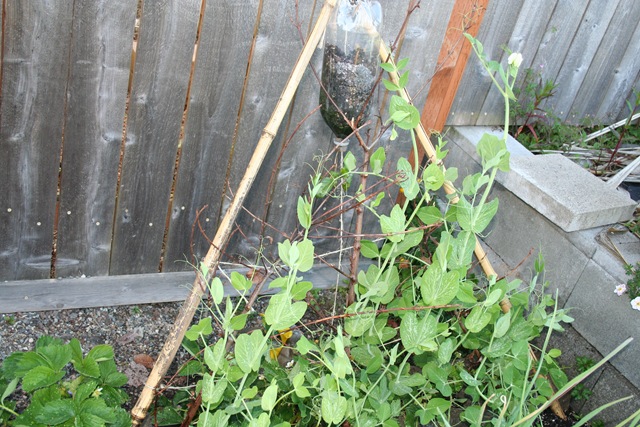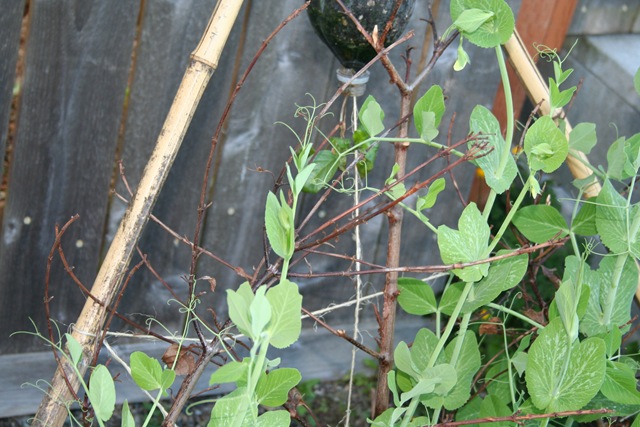Ultimate Plant Cage/Stake/Plant clip review
10 years ago planter, product review, trellis
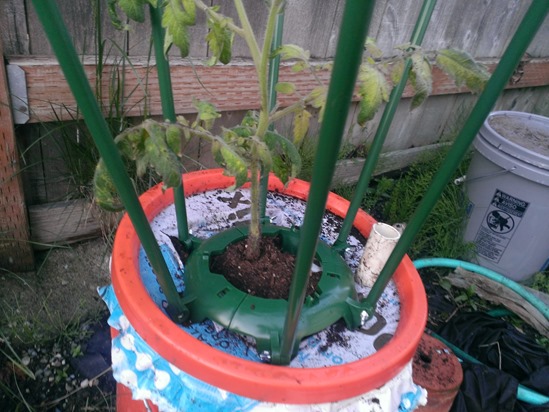
This nice people at Global Garden Friends were nice enough to send me a few of their product to try out with my garden this year and given today I was bringing out my cucumbers, tomatoes, zucchini, and pumpkins from the grow box it seemed like a great time to put them to the test.
The first product I tried out was their Ultimate Plant Cage which is a plastic ring that comes in four parts with spikes you can stab into the soil. I used this on my self watering planter which I just planted a tomato plant into today.
What I like about this system is you can actually assemble this around your plant which is helpful if you are a bit late adding a plant cage to your plants. Also on this right are six small posts which you can attach their Ultimate Plant Stakes (included with the kit) where you can adjust the height and the width as needed to support your growing plant.
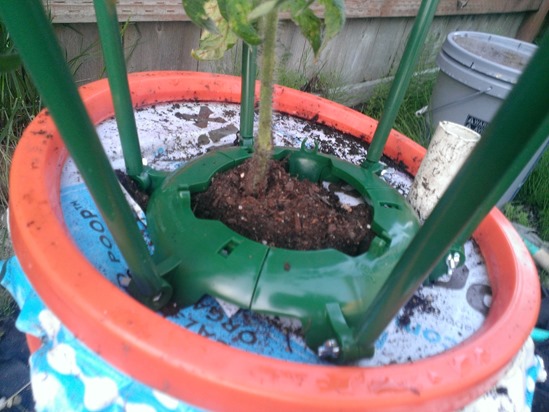
I also use a few more of their Ultimate Plant Stakes to give my peas a little help as they start to take off in the next couple weeks. The only complaint I have for these is there is not a lot of resistance when you extend these stakes so supporting from an angle may work ok but if your weight is a direct downward force I could see these potentially collapsing under some load.
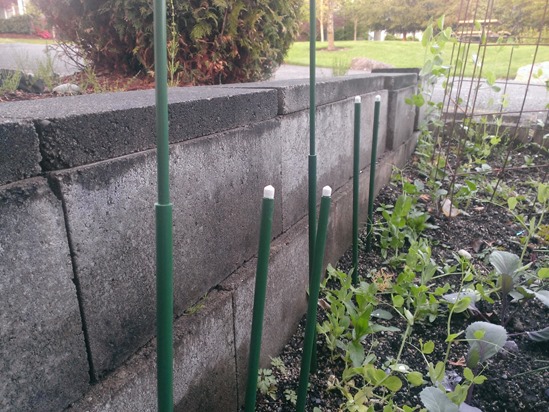
In addition they also sent me some plant clips which you can use to assist your vegetables to climb their trellis until they have adequate support on their own. I have done twine and zip ties in the past but what I like about these is they are much easier to remove when the time comes and also pretty large so easy to find to reuse on other plants as needed.

I suspect I will be able to use them to help my peas, tomatoes, and cucumbers find their trellises when the time comes.
Tags: re
How to make a tomato/cucumber cage
10.8 years ago cheap, cucumbers, DIY, tomato, trellis
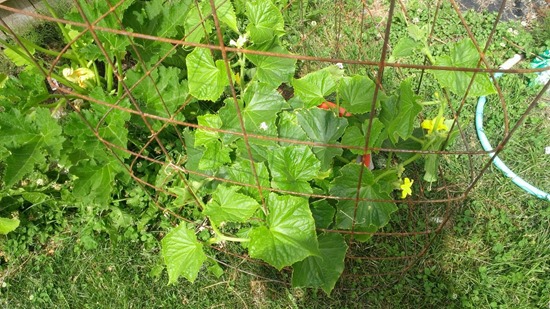
In my area, the tomatoes and cucumbers plants are starting to take off and are in desperate need of some additional support. After walking the aisles of my local home improvement store I couldn’t make myself pay the $15-30 for a single support. Sure they look real pretty but at that price it could take a few seasons to even break even for an inexpensive vegetable like cucumbers.
For this build I wanted something that was inexpensive and would be strong and hold up for years to come. My first thought was cattle panels they are made of 1/4 inch steel. You can find them even thicker if you want, but this size was perfect for my needs and is much easier to work with.
Note: For those observant people out there you may see some similarities between the cucumber/tomato cage and my pea tower…well they are the same thing and in my case I even reused my pea trellis tower to use with my cucumbers when my peas stopped producing. So this is a great multi-tasker in the garden.
Construction
First I started with a 4 foot by 8 foot cattle panel which ran me about $6 at Home Depot.

Given the panel had sharp edges and my largest vehicle is a pretty new minivan with leather seats I planned ahead and started the construction in the Home Depot parking lot (yeah got a couple funny looks) Taking a piece of scrap lumber I brought with me, I placed it on the 5th cross section on one side and bent it up until it was perpendicular to the ground then repeated with the other side.

The I carefully placed the bent panel into my minivan and brought it home for the remaining construction which pretty much was adding a zip tie in the middle to make a isosceles triangle and then tucked both ends to interweave with the other open side of the tower.
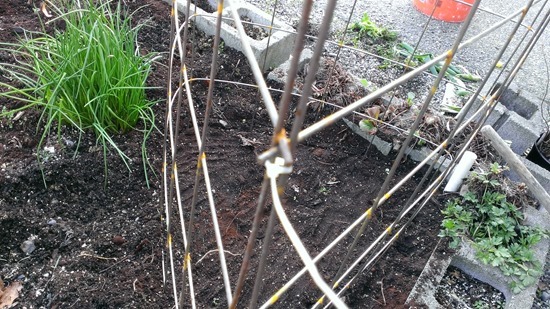
Next I used some pliers to not have as many sharp pointy parts for my kids…probably more likely me to poke myself with and also filed down any ends that seemed overly sharp. If you happen to have an angle grinder this would be a great way to quickly take care of these

Now you have everything constructed all you need to do is carefully place this over your tomato or cucumber plants and they shouldn’t have any problems climbing up this structure. I also just used my foot to push the pointy ends on the bottom into the ground to provide some additional support.
You might also see in this case I am also using a self watering 5 gallon bucket for my planter for this cucumber plant which has been working awesome. Just top off the water every few days and every two weeks include a little fish fertilizer in with the water to keep the growth vigorous.
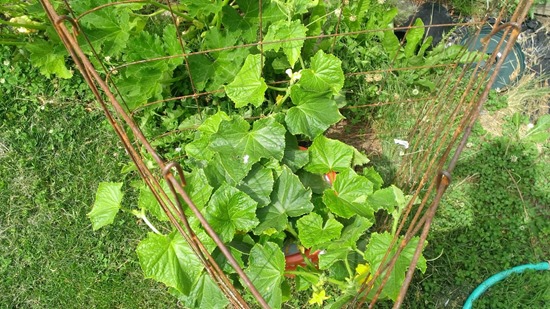
Due to the size and shape of this design it should remain very stable the entire season and many more to come and at just $5-6 a piece and about 5 minutes of work a great value as well.
How to make a pea trellis tower
11.1 years ago cheap, peas, planter, tomato, trellis
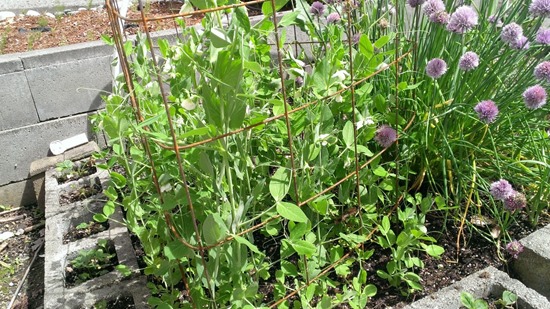
Long time readers know this is not the my first attempt at making a sturdy pea trellis I have had posts and posts about this in the past. Though those creations were a bit cheaper than my current version this one will not be falling down no matter how big those plants get.
First I started with a 4 foot by 8 foot cattle panel which ran me about $6 at Home Depot.

Given the panel had sharp edges and my largest vehicle is a pretty new minivan with leather seats I planned ahead and started the construction in the Home Depot parking lot. Taking a piece of scrap lumber I placed it on the 5th cross section on one side and bent it up until it was perpendicular to the ground then repeated with the other side.

The I carefully placed the bent panel into my minivan and brought it home for the remaining construction which pretty much was adding a zip tie in the middle to make a isosceles triangle and then tucked both ends to interweave with the other open side of the tower.

Next I used some pliers to not have as many sharp pointy parts for my kids…probably more likely me to poke myself with and also filed down any ends that seemed overly sharp.

So I had a bit of a strategy for planting the peas, to know where to plant I placed my tower in the desired spot and wiggles it around to make and outline to plant my peas. I removed it as you can see below and planted two rows of peas inside the perimeter. Then in a few weeks I will plant peas on the outside of the tower. The idea is the peas will grow and climb up the tower and have sunlight and adequate airflow to thrive. Then the second crop will start to grow but by the time it starts to disturb the inside crop they will already be harvested.

I also planted peas on the outside of the tower now on the northern facing side of the tower since it wouldn’t get much sunlight after the interior had a head start.

I know a few of you are probably thinking, “Wow this is awesome for peas, but I bet this would make an real sturdy tomato tower and way better than the ones I can buy in the garden center.” Which I would have to agree with you on that one large enough to provide good airflow and sturdy enough to support and fairly large tomato plant.

Making the Most Out of a Small Space
12.2 years ago cucumbers, peas, trellis
There is a common misconception that you need to have a huge sprawling garden to be able to grow vegetables, but that is simply not true. Even the smallest of gardens can grow sumptuous vegetables. By utilizing the space you have available you can grow a wide variety of climbing vegetables. Whether you have a gazebo, a trellis or just an outside wall you can plant some truly succulent vegetables, which will produce not only food, but also some amazing flowers too.
Runner beans are a great plant to start with; all they need is sunshine and fertile soil. They also produce flowers, which are certainly a welcome addition to any garden. For runner beans you need to either make a wigwam, lashed together with string at the top, or create a parallel row of canes, which are firmly secured to a horizontal cane running along the top. The best time to plant Runner Beans is a week before the last frost; these plants are originally from South America so die out every year after the frost. Runner beans need to be watered particularly heavily, but twice a week in dry weather.
Japanese cucumbers, which will reach several feet, are a more demanding vegetable, and require different types of fertilizer at different times of the development, although all the hard work is certainly worth it, especially when you get to taste your produce. Although not widely known, several of the smaller pumpkin species, including trailing pumpkins, can be grown vertically. These are easy to grow and even easier to cook and enjoy! Marrows will also clamber over fences, or up trellises. All you need to do is prepare the soil well, with lots of fertilizer.
There are hundreds of things that you can grow up a trellis over a wall and even up a gazebo, so this spring make the most out of the space you have!
How to make a cheap pea trellis
14.9 years ago cheap, peas, trellis
This is really two trellises in one. I started by taking a couple bamboo stakes (reused from a couple of one season too long Halloween scarecrows) and bound them together at the top using some twine. I then put the ends in the corners of my garden leaning against the cinder blocks surrounding my raised garden. I following this by adding some twine up the trellis to allow the peas to climb up.
Thing started to get a little crowded so I browed a tip from Martha Stewart, now she recommends black birch branches, but I decided to go with the dead bush I had in my back yard. I was already chopping it up to compost so saved some of the larger branches, stabbed them in the ground and ala pea trellis.
Though the two part trellis was more of an accident, in many ways I really like the support of the bamboo along with the abstract reach of the branches.
Tags: cheap, compost, raised garden

